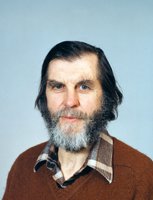Jim joined the physics department in 1959 and was the main instigator in starting the particle physics/HEP experimental group in the 1960s. During that decade and into the 1970s the group concentrated on analyzing film from large bubble chamber experiments at Argonne National Laboratory and Fermilab and built up a strong team for scanning and digitizing the track information from the observed particle interactions using PDP computers. The physics emphasis at the time was on finding new particle resonances in the “particle zoo” that was emerging and analyzing their properties.
In the 1970s the group’s focus shifted to so-called “counter” experiments, which measured high energy particle interactions using electronic techniques for reading out detectors such as scintillator arrays, spark chambers, wire proportional chambers and Cerenkov counters. Jim and some other group members joined an experiment called the charged and neutral spectrometer at Argonne National Laboratory led by Ohio State University. This experiment focussed on studying particles decaying to photons, which were measured using spark chambers built at Toronto. The group’s work shifted to Fermilab in the mid seventies and Jim was the Toronto leader in a collaboration with groups from the University of California at Santa Barbara and Fermilab that made the first high-energy measurements of the photon total cross-section on the proton and some heavy nuclei.
After the discovery of the charm quark in 1974, many experiments were mounted at Fermilab to attempt to study its properties. One of the first and arguably best was E531, which included Jim and other Toronto group members, Ohio State University and Nagoya University. This experiment made the first measurements of charmed particle lifetimes by producing the particles in an emulsion target with a neutrino beam. Particle tracks measured in drift chambers built at Toronto were traced back into the processed emulsion for each “event” to find the neutrino interaction vertex and the charmed particle produced, which decayed typically less than a millimetre from the vertex.
In the 1980s the group moved its activities gradually to Europe. Jim led Toronto into the ARGUS collaboration that was using the DORIS electron-positron collider at the DESY laboratory in Hamburg to produce hadrons with bottom quarks. This experiment was very successful and in particular discovered a surprisingly large mixing of neutral B and anti-B mesons (neutral mesons containing the bottom quark), which indicated that the undiscovered top quark was much heavier than thought at the time. A precision cylindrical vertex chamber was built at Toronto for this experiment. Jim also was involved in the ZEUS collaboration at the HERA electron-proton collider at DESY, which made finely detailed measurements of the inner workings of the proton. This was his last experiment before retirement in 1994.
In the late 1960s Jim was involved with a Canadian group who applied to the National Research Council and the Canadian government to make a contribution to the Fermilab laboratory near Chicago, Illinois. This was unsuccessful, but led to the formation of the Institute of Particle Physics, a national organization that coordinated and helped bring together all the Canadian particle physicists to work collaboratively on ever larger projects. Jim was heavily involved in this process, and eventually served a five-year term as director of IPP from 1976-81.
His scientific legacy is not just the 220 peer-reviewed articles that he authored and co-authored, but the many students and postdoctoral fellows he trained over his 35-year career at the University of Toronto.
- Stephen Julian, Pekka Sinervo and John Martin
Jim Prentice's Career in Nuclear Physics
He, with Henry Caplan and N W Gebbie (Can J Phys 1963 19(3019-20), did some very fine work using the 4MV Van de Graaff at the old Princess Margaret Hospital on the gamma rays from the nucleus 19F, which at that time was of great interest to the developing collective model of the nucleus. Then when the EN Tandem was to be replaced by the MP Tandem at Chalk River in about 1962, Jim and others tried to get it to be relocated at the University of Toronto, instead of buying an electron Linac. They lost that struggle with Ken McNeill who wanted an electron linear accelerator - the Linac. So the EN tandem instead went to the University of Montreal where it is, I believe, still operating. The ill fated Linac was not viewed by the NRC and AECB committees with much favour and the apparent crisis resulted in Harry Welsh asking me to join the Physics Department. In those days Harry Welsh was persuaded to do so by Professors Lynn Trainor and Bill Sharp from Applied Mathematics.
The idea for IsoTrace was already born by 1961 at Chalk River, so if the tandem had later come to the U of T and IF I had come also (not likely I expect), the science done here might have been quite different. Who knows what also might have been changed too. Instead when I came to Toronto I carried on here with the VdG at the PMH with Dick Azuma and students and with students on the Linac. After the Linac closure, IsoTrace was later born at the University of Rochester with my help and that of the U of T students. Later in 1979 with assistance from Prof D W Strangway of Geology a machine for isoTrace was obtained for the U of T.
- Ted Litherland

